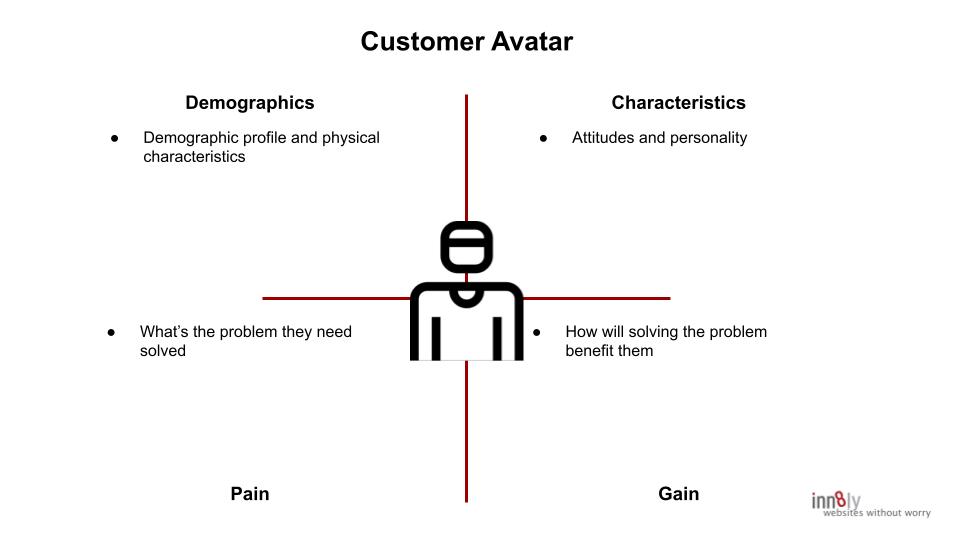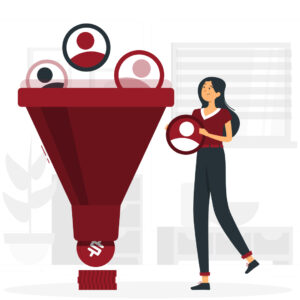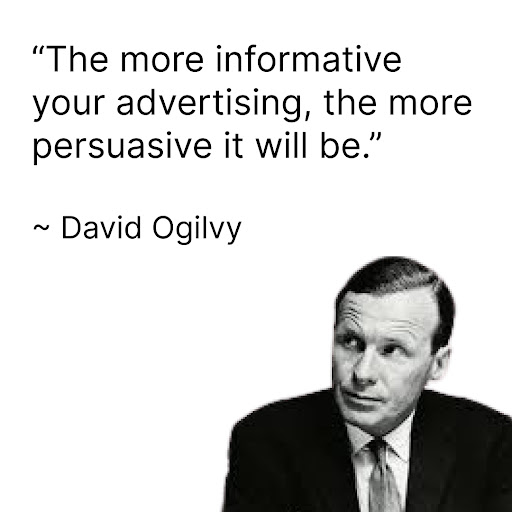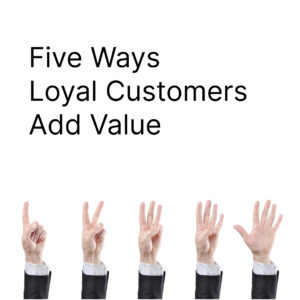“Marketing isn’t important.”
“Oh really? What’s important then?”
“Effective marketing is important.”
“So, effective marketing begins with a good product?”
“A good product is important, but effective marketing starts and ends with customers.”
The Most Effective Marketing Starts and Ends With Customers
Yup, that’s it. Your marketing strategy starts and ends in one place. And that place is not your products, it’s not even inside your business.
Consider who your prime prospects are and what they need. What problem are they trying to solve? Using an outside-in perspective converts your marketing from expensive noise into a value-creation machine.
It’s also important to recognize that your prime prospects are on a journey.
Most of the time, they aren’t interested, so they won’t see your marketing. Sorry. I know that this is scary, but, all the marketing activity in the world won’t change a customer’s need state. When their needs change, when their interest in the category increases, they will become aware of your marketing activity and your competition’s marketing. You want to be there when they are ready with the right message.
To accomplish this, you need a simple marketing plan. This is also essential for an effective business website.
Let’s dig in and review what this means.
A Marketing Strategy That Works 🌟
A successful marketing strategy does three things: it targets the right prospects, supports their entire journey, and recognizes that the first purchase isn’t the end of the journey.
Know Your Customer Base
Among your existing and potential customers, a smaller group of customers drives most of your revenue. These ‘best customers’ are not the same as regular customers. They are generally heavy category users who have a significant need for your product or service. This need generates heightened interest in category activity. They are more knowledgeable than the average and more aware of marketing, yours and your competition’s.

A deep understanding of their needs and how they differ from the majority will lead to better marketing strategies. Marketing that attracts potential customers just like them to your business. Prepare a four-quadrant avatar that describes your best customers.
Focus is your friend in this work. Identify the key aspects in each area that differentiate the best customers from average customers. The four areas are demographics (physical characteristics), characteristics (attitudes), pain (problems), and gain (your offer).
Demographics:
Focus on the demographics that differentiate the best customers from average customers. This can include factors such as age, gender, income level, education level, occupation, and location.
For instance, if you are selling luxury items, your best customers might be middle-aged or older individuals with high-income levels and a high level of education. On the other hand, if you are selling products targeted at teenagers, your best customers might be younger individuals with less disposable income and a preference for trendy products. “Women 18 – 49” is not what you want in the avatar.
Customer Avatars 🌟
A customer avatar is a detailed description of your best customers. It has four sections: Demographics, Characteristics, Pain, and Gain.
Characteristics:
Look for the characteristics or attitudes that differentiate the best customers from average customers, including personality traits, interests, values, beliefs, and behaviors.
For example, if you are selling eco-friendly products, your best customers might be individuals who prioritize sustainability and are willing to pay more for products that align with their values. In contrast, if you are selling products aimed at fitness enthusiasts, your best customers might be individuals who are disciplined, motivated, and committed to a healthy lifestyle.
Pain:

Pain is the most important animal. Identify the problem that heavy category users have. This is likely not the same as average customers. You want to differentiate the best customers from average customers and emphasize the specific issues or challenges your product or service solves.
If you are selling skincare products, your best customers might be individuals with specific skin concerns, such as chronic acne or aging. They might be willing to invest more in high-quality products that address their issues effectively. They will also purchase the product more frequently. Similarly, if you are selling financial services, your best customers might be individuals who are concerned about retirement planning or managing debt.
Gain:
Use the previous areas to help you determine the best solution for best customers. The product or service you select will also attract average customers, but by focusing on the benefits most important to prime prospects, your offer will attract more heavy category users.
For example, if you are selling a software tool for businesses, your best customers might be those with large teams who are looking to improve productivity, save time, or reduce costs. They will be more interested in features that help them streamline processes and boost productivity. Or, if you are selling luxury experiences, your best customers might be those who are looking for unique, memorable experiences that they can share with others. They will be willing to pay more for personalized attention and exclusive perks.
A typical target audience is broad. Your prime prospects are a subset of your target market. They are similar to your best customers and are your ideal target customers. There are likely two to three subsegments within this target audience. Once you have identified these subsegments, create an avatar for each subsegment. There will be similarities with the overall avatar, so focus on the differences.
Map the Buyer’s Journey

Get the right message to the right person at the right time.
~ Direct Marketing Axiom
Mapping the buyer’s journey is a vital but often overlooked step. A customer journey map helps you choose what to say and when to say it. Consider the direct marketing axiom,
“Get the right message to the right person at the right time.”
Without a journey map, your marketing efforts are throwing content and hope against the wall. This isn’t a plan. Basically, your marketing is, at best, a dot among many that swirl around your prime prospects without notice.
So what happens? What’s the trigger event that brings your potential customers’ needs to the forefront?
This is the beginning of their journey.
What information are they looking for? If your marketing is designed to resonate with this initial event, your marketing will attract more customers to the top of your marketing funnel.
Asses the steps they go through on their journey to purchase. What challenges (obstacles and objections) need to be overcome? What questions need to be answered? Document the events over their entire journey.
For more of the journey map, read our post, Mapping the Customer Journey.
Let’s look at the big picture.

Not Aware
Most of the time, your marketing efforts are for most of your target audience isn’t in the market for your product or service, so your ads are just more digital noise. Sorry, but this is the truth.
As I mentioned above, the best advertising ever created won’t cause a change in need state. It’s important to be there, and it’s important to have triggers set. When a prospect raises their hand, you want to be there.
Consideration
After they raise their hand, the first phase is Consideration. In this stage, your target customers recognize that there’s a problem to be solved. Their interest in finding a solution increases. This parallels an increase in their interest and, therefore, their awareness of your and your competitor’s marketing activity. They begin to consider their options and become aware of all the category marketing.
Prospecting
Once they have a path, their interest increases again, and they enter the prospecting stage. In this phase, they are looking at and narrowing their choices. This usually results in two or three top contenders. If you have done a good job building customer loyalty, the process will be over quickly, and they will buy again, but don’t be fooled; the stages I’m describing always exist.
The next section will describe how to craft marketing strategies that utilize the insights gained to support your target market on their buyer’s journey.
Use the Avatar and Journey Map to Build a Non-Icky Marketing Funnel
The avatar and journey map give you all the information you need to craft a marketing strategy often called a marketing funnel, that’s designed to attract the right customers for the right reasons.
Using the Customer Avatar
As mentioned above, the customer avatar has four quadrants.
- Demographics help you choose media channels.
- Characteristics set the tone for ad design and copy.
- Pain identifies the problem you will focus on.
- And Gain tells you what your lead offer should be.
Using the Journey Map

The journey map gives you the guidance you need to draw your prime prospects into a series of increasing-value interactions that build knowledge, like, and trust.
For example, your top-of-funnel tactics and messaging should address the issues and questions your prospects are considering as they begin their journey.
Mid-funnel tactics and messaging support the transition from consideration to prospecting. If the top-of-funnel tactics are designed to attract, the mid-funnel tactics should be designed to nurture.
Bottom-of-the-funnel tactics should be focused on reinforcing the value proposition and providing the incentives needed to take the next step.
A marketing plan designed in this way will attract more prime prospects and build relationship equity throughout the buyer’s journey. You want the purchase decision to be the next logical step in their journey. It shouldn’t be something you need to convince them to do. Why is this true? I’m glad you asked.
The Most Important Sale Isn’t the First Sale
If the marketing funnel has done its job, the first purchase is the next logical step in your prime prospect’s journey. But your job isn’t over. Your customers’ interest is still high, and they are still very aware of your marketing and your competition’s marketing.
They are looking for reinforcement.
Have they made a good choice?
Do you value their business?
Your sales funnel contains the promotional tactics you have in place that are designed to nurture the relationship with new customers and get them to purchase from you again. This is important because customers who buy from you twice are much more likely to buy from you in the future.
Repeat purchases are the engine of business growth. This is easier when the marketing strategies that brought them to your solution focused on building the relationship.
Effective Sales Funnels
The best marketing strategies include a plan for post-sale value creation. Share valuable content with your new customers. Use the e-commerce thank you page to give new customers information about the product or service they’ve just purchased. Use email marketing to demonstrate how much you value their business. Automated email marketing campaigns and transactional emails are perfect for this. Remarketing using social media advertising is another way to reach recent customers and give them a way to buy from you again.
These are proven techniques. RFM targeting results in successful marketing strategies because it’s based on the proven idea that the customer who bought from you most recently, who buys from you most frequently, and who spends the most with you is the customer most likely to buy from you again. RFM marketing strategies are extremely effective.
What you do immediately after a purchase, especially the first purchase, builds relationship equity and creates loyal customers. Have a marketing plan in place that takes advantage of this opportunity.
Let’s circle back to an idea introduced above; your best customers are likely heavy category users. They have an above-average need for what you are selling. Customer marketing strategies won’t put them off. In fact, they will value the information and the attention.
Is this effort worth it?
How Best Customers Bring Value to Your Business

Loyal customers bring value to your business in five ways.
- The ROI increases the longer they stay
- They know how it works, so the cost less to service
- More efficient marketing because they are more likely to buy again
- They see the value, so you don’t need to bribe them to buy again
- They advocate for you
This is true for all your customers, but the impact is magnified if you’ve attracted heavy category users.
Plans For Mutual Value
A successful marketing strategy is an outside-in process. This idea is reflected in the customer avatar and the buyer’s journey described above.
Know your customers, especially your best customers. Understanding their demographics determines media channels. Their attitudes set the marketing tone. Identify their pain; this drives messaging and their pain, which informs your offer.
Map their journey from no need to purchase. Design inbound marketing so marketing messages answer their questions and address their concerns.
These two planning tools, the customer avatar and journey map, drive the choices you make when you design your funnel. A funnel that supports the journey your best customers take leads to a purchase made for the right reasons.
Recognize that the most essential purchase is the second purchase. Bake this into your plan.
Have a sales funnel in place that reinforces and builds a relationship with your customers. Their interest doesn’t vanish when they purchase. It remains high, and they are paying attention to what you do and don’t do. Don’t miss out on this opportunity.
Conclusion – Customer-Driven Marketing Strategies that Drive Business Growth
When it comes to marketing, it all begins and ends with your customers. By taking an outside-in perspective and considering your prime prospects and their needs, your marketing can transform from being just noise to a business growth machine.
To craft a marketing plan, it’s important to understand who your best customers are and create a detailed customer avatar for them. Use this avatar to differentiate them from the average customer and identify the aspects that make them unique. Additionally, mapping the buyer’s journey is crucial to determine what to say and when to say it to overcome their obstacles and concerns.
With this information, you can build a marketing funnel that attracts the right customers for the right reasons. Use the avatar to choose media channels, set the tone for ad design and copy, identify the problem you will focus on, and determine your lead offer. Additionally, use the journey map to craft marketing messages and offers that draw prime prospects into a series of increasing value interactions that build know, like, and trust.
But don’t stop there. The most important sale isn’t the first sale. Your marketing strategies should continue post-sale to build a relationship with your new customers and get them to purchase from you again. By focusing on value creation and demonstrating how much you value their business, you can create loyal customers who bring value to your business in many ways.
A marketing plan crafted to generate mutual value, value for the customer, and value for the business starts and ends in the same place – your best customers. By understanding their needs and building a relationship with them, you can create growth strategies and marketing campaigns that attract the right customers for the right reasons.
FAQs
The main principle behind an effective marketing plan is to start and end with the customers. This outside-in perspective helps convert marketing from expensive noise into a value-creation machine.
Prime prospects are a subset of your target audience, similar to your best customers. To identify them, create a four-quadrant avatar for your best customers and then identify two to three subsegments within your target audience that share similarities with the overall avatar.
A customer avatar is a detailed description of your best customers, divided into four sections: Demographics, Characteristics, Pain, and Gain. This avatar helps you understand the unique aspects of your best customers and how they differ from average customers.
Mapping the buyer’s journey is vital because it helps you choose the right message, deliver it to the right person, and do so at the right time. Without a journey map, your marketing efforts are less targeted and less likely to resonate with prime prospects.
A buyer’s journey has three stages: unaware, consideration, and prospecting. In the unaware stage, your target audience is generally not in the market for your product or service, so it is unlikely they’ll see your marketing. In the consideration stage, they recognize that they have a problem and will start considering solutions. They will also start seeing marketing, yours, and your competitors. In the prospecting stage, they narrow down their choices and evaluate top contenders before making a purchase decision.
Profitable Google Ads – 7 Steps to a Revenue Faucet
Learn how profitable Google Ads Search campaigns are possible and likely if marketers are patient and make data-driven adjustments.
Want to Increase Marketing Effectiveness?
Maximize marketing ROI with performance tracking.
Unlock the Power of Email Marketing for Your Business
This power and importance of email marketing to your business success.
Author: James Hipkin
Since 2010, James Hipkin has built his clients’ businesses with digital marketing. Today, James is passionate about websites and helping the rest of us understand online marketing. His customers value his jargon-free, common-sense approach. “James explains the ins and outs of digital marketing in ways that make sense.”
Use this link to book a meeting time with James.

